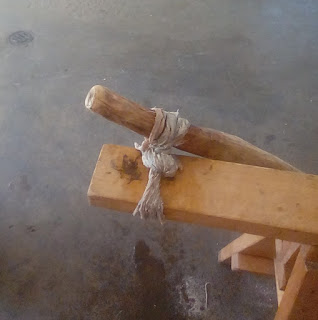Bow Backing
Next time you snach a moose, scrape the hide (hair and flesh side), cut it length wise, hang it to dry. You won't build enough bows to go through the hole hide as bow backing. If you don't hunt moose yet, talk to a person that can get you a hide.
I prefer a backed bow with a toasted stave. The backing will hold splintering and back fracturing, giving the bow far more integrity to take a lot less carful over draws (this will compress the wood however). Backed bows are just hard to break.
Contrary to what I have heard from a far more experienced bowyer, I dont find a very thick hide nearing to the tips, detrimental to bow performance. Hide has far more strength per ounce than wood so a hide backed bow can be thinner, and lighter, than a self full wood bow of equal draw strength and speed. Again however, this is just my very limited experience from building my own bows.
Rough up the back surface before applying glue to increase the surface area.
Regardless the back (sinew, cotton, hide, &c. ) always tripple, or quadruple a hide glue layer, which are allowed to dry, before applying the backing; this will inundate the surface with a dry wood glue layer, seeping and filling every pore, readying the surface for the glue soaked backing to ultimately make the backing material and the wood realy become one; these layers should be thin to ultimately make a thick layer.
When using hide to back bows, the flesh side of the hide is usually glued to wood back; this hide surface MUST be well scraped; if it is not, the glue will adhere only to the sinewey stuff on the surface of the hide and not the skin fibers, and the back in that area will peel away as the bow is used.
Wrap well with a cotton wrap while drying. The same bowyer mentioned earlier (Clay Haines) suggested using a weighted sleeve slid on the limb to keep the backing down while drying.
When sinew backing, don't be afraid to use glue generously to coat the wood well before the first layer of sinew and after subsequent layers to fill gaps and coat. My first sinew backed bow was perfectly backed and featured ZERO cracking or sinew snapping sounds when drawn. The sinews were individually, randomly placed to three layers and the sinews reaching beyond the tips, curled over the tip and back on the belly; a final, light strap of sinews was formed arround the bow, just under the nocks for security; this demonstrates to me, that sinew snapping may be the result of using leg sinews, which aren't really long individual strands, like the back sinew and a few others, but more woven sinew type strands. I found that a tamped sinew leg bundle - the "standard" procedure for dividing and loosening sinews - were easy to break in my hands.Tamping seems to dammage the sinews.
The best material to use for sinew backing is the long back strap. Curl the sinew over a thin round tool, and they will separate. When loose, pull apart dry.
Many long back sinews were used in the backing, and in my dry climate of Alberta, only nine or so days were waited from the final wet sinew, when I began final tiller; you dont need to wait six months.
Sinew backed bow is a new experience in self made bows. The bows seem to loose little power over heavy use, making them apparently indestructible. Is sinew necissary? Sometimes, but a serviceable bow does not need sinew. Though hard to make, sinew seems to hold the investment; a statement I was strongly skeptical about before. A sinew bow will go to hell with you and not wine about it, unless its damp or wet. Compared to self bows, cable back bows, or hide backed bow, the sinew bow needs almost no mantenace over long and heavy use; a recoat of hot hide glue one the surfance now and then.
Always use hide glue hot or warm, and never room temperature. The glue will flake off and not adhere properly if its applied at room temperature or cold bit still liquid. When refinishing the back periodically, rememeber what has been said.
For a quick and dirty, when the bow needs a bit more punch, has lost its punch, even with a hide or sinew back already there, throw a cable on - any will do. I have used sinew, hide, hide from the borders of my smoked skins. Twist, secure, wrap and shoot. Its prudent to let off the cable at the end of the shoot session; this can be a pain in the butt, but the cable back is usually a temporary fix.
Sinew has thus far been the most well performing back, of the three mentioned, by far and not much harder to apply than any other.



